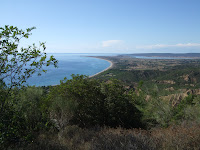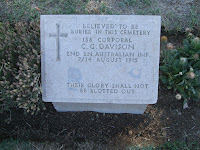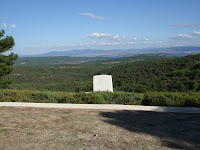And so I went to Gallipoli to see where all of this happened. It was cold and wet when we left the hotel in Istanbul (and early too) but, by the time we arrived at the Peninsula at lunchtime, it was hot and sunny. It was a very long day as I didn’t arrive back at my hotel until after 11.00 pm. Our guide was a young Turkish man who had made a study of the Gallipoli campaign from both sides of the war. His enthusiasm was contagious and his knowledge of dates and numbers and strategies was astounding and I wish I could remember some of them. No notes, no remember. However, all the names of places that we remember are all quite close geographically and it bears testament to the ferocity of the fighting in the Gallipoli campaign.
I couldn’t marry what I had seen and read in books and seen on TV with what was concrete before my eyes and under my feet. I saw the cemeteries. I saw the memorials. I saw the statues, the trenches and the tunnels dug by the “Diggers”. I saw how close enemy trenches were. I saw the ridges the diggers were ordered to climb and conquer. I heard the facts. It just didn’t add up at the time.
But now that I’m home, it’s starting to sink in that I was really there where all those young men fought, lost their lives and dug in for what was a hopelessly mismanaged campaign. I now have a much deeper appreciation, thanks to our guide, of both sides of the story and how difficult it was for everyone involved and what the “Gentleman’s War” means. I also have a new appreciation of the dreadful sacrifices made by the Maori soldiers of New Zealand at Gallipoli.
We visited the joint Turkish and ANZAC Memorial and Museum at Kabatepe with a magnificent outlook to the Aegean.
We stood in trenches and beside tunnels.

We saw Lone Pine and Suvla Bay.
 |
| Lone Pine. |
 |
| Suvla Bay. |
There was Simpson’s grave and Shrapnel Gully where he distinguished himself. However, when he was rescuing the wounded it was bare of foliage with Turkish snipers on one side of the valley.
 |
| Shrapnel Gully. |
For some, the fighting was so fierce, no one was sure of when they died.
 |
| When did he die? |
We stood at the place where whole families of Maori soldiers gave their lives to win a hill only for it to be lost later.
And close by the trophy, the Dardenelles.
 |
| Dardenelles over the hill. |
Some relics.
And then when the horrors of Gallipoli were finished, the survivors went to the Western Front ......







No comments:
Post a Comment